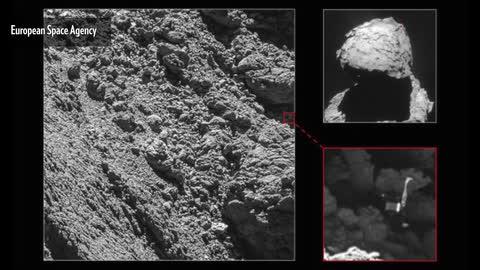Lost-in-space Philae probe found in 'dark crack'

A space probe that European scientists lost two years ago after it crash-landed on a comet, lost battery power and got stuck in a "dark crack" has been found, the European Space Agency said Monday.
The missing Philae robot was located Friday by cameras attached to the agency's in-orbit Rosetta spacecraft. Images showed Philae's distinctive box shape and two of its three legs wedged underneath a rocky overhang on Comet 67P/Churyumov–Gerasimenko.
"This remarkable discovery comes at the end of a long, painstaking search,” said Patrick Martin, the European agency's Rosetta mission manager. “We were beginning to think that Philae would remain lost forever."
The agency launched Rosetta in 2004. After 10 years spent catching up with Comet 67P/Churyumov–Gerasimenko — a frozen mass part of the Jupiter family that is about 3 miles wide — the agency finally dropped the smaller Philae lander on the comet in November 2014. That was the first time scientists had landed a probe on a comet.
Its mission was to capture information about the comet's composition and to transmit it back to Earth.
But Philae bounced after its initial touchdown and its precise whereabouts were not known. It sent data back to Earth for about three days before its solar battery ran out, and it went into hibernation, only to recharge enough as the comet came closer to the sun. It briefly communicated with Rosetta in mid-2015.
“This wonderful news means that we now have the missing ‘ground-truth’ information needed to put Philae’s three days of science into proper context," said Matt Taylor, the agency's Rosetta project scientist. "Now that we know where that ground actually is!” he added.
Philae's discovery comes less than a month before the Rosetta spacecraft itself is due to land Sept. 30 on the surface of Comet 67P/Churyumov–Gerasimenko. Rosetta's mission, however, will be deliberately one-way: Scientists intend to crash-land the Rosetta in order to investigate the comet's surface up close and hopefully reveal secrets about its structure.